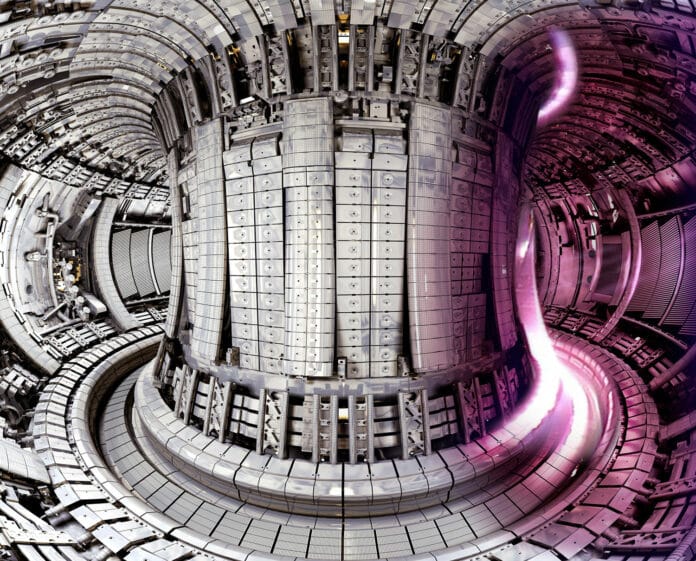In a major scientific achievement, European researchers at the Joint European Torus (JET) facility have set a new world energy record of 69 megajoules released in sustained and controlled fusion energy. This breakthrough is a result of their experimental campaign to verify operating scenarios for future fusion machines under conditions as close as possible to those in ITER and future fusion power plants.
The EUROfusion consortium of fusion laboratories around Europe embarked on an ambitious experimental campaign at the JET facility of the U.K. Atomic Energy Authority (UKAEA) in Culham, U.K., in September 2023. Their aim is to test out operating scenarios extrapolated from small and medium-sized European devices to pave the way for the international ITER project and the fusion power plants to follow.
JET is unique amongst present-day tokamak machines, which trap a donut-shaped cloud of hot, ionized fuel or plasma in a cage of magnetic fields, as it can work with the deuterium-tritium fuel that will form the basis of future fusion machines like ITER and the demonstration power plant DEMO.
The researchers at the JET facility of the U.K. Atomic Energy Authority (UKAEA) have set a new fusion energy record of 69.26 megajoules of heat released during a single pulse, thanks to advanced scenarios used to structure and control their plasma. This significant breakthrough was achieved by releasing the energy over six seconds from only 0.21 milligrams of fuel. The energy record equals the energy released from burning 2 kilograms of coal.
The EUROfusion team’s new achievement breaks their previous world records of 59 megajoules (2022) and 22.7 megajoules (1997), which were also set at JET. The scientists at JET were able to reproduce the necessary fusion conditions for the new record reliably in multiple experimental pulses, demonstrating the understanding and control they have achieved over the complex fusion processes.
The record-breaking feat was achieved by heating a plasma of deuterium and tritium, which are two hydrogen isotopes, to a temperature of 150 million degrees Celsius.
Due to their high fusion cross-section and low ignition temperature, deuterium and tritium are the best candidates for fusion energy. Deuterium is found in seawater, while tritium can be produced from lithium, which is a common metal.
Deuterium and tritium fuse together to form helium and release tremendous heat energy without any greenhouse contributions. Fusion is inherently safe in that it cannot start a run-away process and produces no long-lived waste.
“We can reliably create fusion plasmas using the same fuel mixture to be used by commercial fusion energy powerplants, showcasing the advanced expertise developed over time,” said Dr Fernanda Rimini, JET Senior Exploitation Manager, JET Scientific Operations Leader.
“Our successful demonstration of operational scenarios for future fusion machines like ITER and DEMO, validated by the new energy record, instill greater confidence in the development of fusion energy,” said Professor Ambrogio Fasoli, Programme Manager (CEO) at EUROfusion. “Beyond setting a new record, we achieved things we’ve never done before and deepened our understanding of fusion physics.”
JET has been a remarkable achievement in the field of fusion energy research. It has been the largest and most successful fusion experiment in the world and a central research facility of the European Fusion Programme. Since its inception in 1983 as a joint European project, JET has pursued safe, low-carbon, and sustainable fusion energy solutions to meet the world’s future energy demands. It has provided crucial insights into the complex mechanics of fusion, allowing scientists to plan the international fusion experiment ITER and DEMO, the demonstration fusion power plant currently under design by the European fusion community.
Built in Europe and used collaboratively by European researchers over its lifetime, JET became UKAEA property in October 2021. The machine celebrated its 40th anniversary in June this year and ceased plasma operations at the end of 2023, having created 105,842 pulses.
